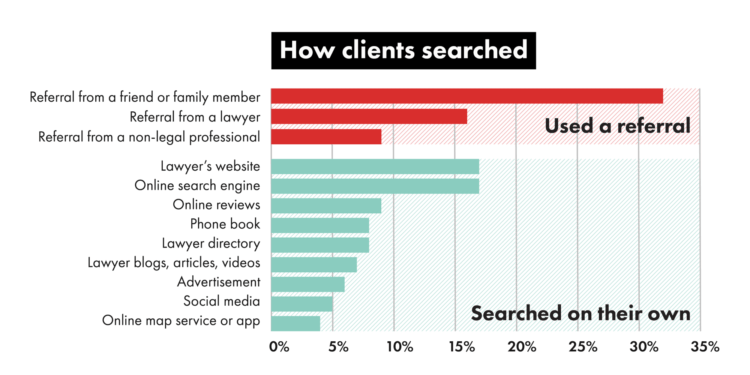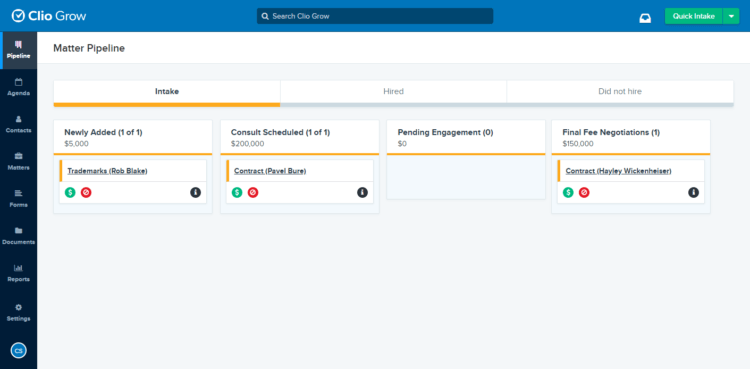Relationship building. Pressing the flesh. Developing new revenue streams. Cross-selling. This is the language of business development, and, much like marketing terminology, it is not familiar territory for most lawyers. As much as I’m prone to preaching about the place for marketing in every law firm’s toolkit, business development for law firms is the other side of the coin.
After reading this article, you will have a good idea of what business development strategies look like for law firms, and some practical tips on how to integrate them into your job as a lawyer and business owner.
What is law firm business development?
Business development for law firms means pursuing strategic opportunities for your law firm. This includes building new relationships and identifying new revenue streams and sales opportunities. Examples are cross-selling to existing clients and adding new practice areas to your firm. It might involve geographic expansion, or setting up procedures for your client intake team to follow up with prospects.
Law firm business development vs. marketing
One of the reasons I love marketing is because you can seemingly create new business out of the blue. And depending on the advertising channel, the results can be instantaneous, through techniques such as turning on pay-per-click (PPC) ads and other forms of Google advertising. John Grisham writes books about the rainmaker, and that is precisely what a good marketing person is—a rainmaker.
In business development for lawyers, you’re still making it rain, but instead of the sales-focus one-time transactions of marketing, you build bridges, relationships, and revenue streams that are more sustainable and will serve you in the long run.
One might say that marketing is the here and now, putting your law firm in front of a client who needs your services and securing retainers. Unlike marketing, business development for law firms is about the long game—adding revenue and sales streams, practice areas, and relationships that build your practice over time.
You may like these posts
What does law firm business development mean for lawyers?
Law firm business development essentially means anything you do, in a systematic way, that expands your firm’s revenue streams. It takes into account strategies to grow revenue from a big-picture perspective rather than one-time transactional decisions.
I know what you’re thinking: “Okay, so what does this mean to me, a sole practitioner (or lawyer at a small firm)?”
Top 3 strategies for law firm business development
Here are a few of the most common strategies lawyers of any size can use to grow new business:
1. Build strong client relationships

The best way to get a new client is through existing clients. The 2020 Legal Trends Report reveals that a client looking for a lawyer will trust recommendations from friends and family first as well as online reviews on Google, social media, legal directories, or from past clients.
To ensure that past clients lead to referrals for new clients, law firms need to become client-centered and develop strong client relationships, both during and after the case. There are many ways to do this, but it largely boils down to making the client experience exceptional.

Other findings from the 2019 Legal Trends Report shows that communicating consistently and clearly, answering client inquiries, and being transparent with billing are all ways to make sure your clients feel they are getting the best possible experience and feel important.
To build strong relationships, focus on the five key aspects of running a client-centered law firm.

- See things from your client’s perspective
Creating a better client journey and overall client experience at your law firm means truly seeing things from your client’s perspective. Don’t make assumptions. Stay engaged with your clients and look for opportunities to get insight into their experiences.
- Care for your clients and consider their needs
Your clients don’t just come to you to get legal issues resolved. They come to you for peace of mind, reassurance, emotional support, advice, and more, during very stressful times in their lives. Lean into this with empathy and you could help your law firm stand out in a big way.
- Be client-centric in your thinking
When your law firm makes a decision, evaluates a new tool, or tries a new process, do you think about how it will impact your clients and their experiences? Thinking of your clients first at every stage of the client journey is the first critical step towards running a more client-centered practice.
- Communicate clearly and often
For client-centered law firms, communication means more than just providing updates on clients cases. It’s about being proactive so that clients feel informed, and taking the time to ensure clients truly understand everything that is going on. This is important throughout the entire client journey, from intake to invoice.
- Ask for feedback to continually improve the client experience
Don’t forget to ask for feedback from your clients. The best way to validate if your client experience is meeting expectations is to get feedback right from the source. Consider measuring client satisfaction as you go. Remember the old adage: “What gets measured gets managed.”
One very common way to do this is by measuring your Net Promoter Score (NPS®). The NPS® is a way of measuring which clients are likely to spread the good word about your service to others through reviews and referrals. You’ll also want to be proactive about managing your online reputation. This includes responding to negative reviews and asking current and former clients for feedback and positive reviews.
2. Networking

Truthfully, I didn’t become comfortable with networking until many years into my career. I needed to feel like I had something to give others versus acting like a recent law school graduate who was desperate for a job.
Nonetheless, law firm networking is something you have to do. My advice would be to forget about your hang-ups, force yourself to get out there, and just talk to people without having a motive or professional objective such as marketing in mind. Be yourself and create relationships. Once you’re more comfortable, you can think about how to get more out of your networking. For now, just showing up is a good start. And if you’re the type to drop social events the moment you get busy at work, using the conversation list strategy for law firm business development to maintain your relationships is a great way to stay social.
Remember, networking doesn’t just mean going to bar events. Think hard about what makes most sense for your practice area. Will most of your clients come from other lawyers? Or will they come from other professionals?
I know an attorney who built an entire book of business through referrals by rubbing elbows in professional organizations such as BNI and by being active in her local bar and practice area section. In fact, at the law firm we worked at, she brought in more than three times her salary in billable hours through referrals.
Another attorney did QDROs. Because new business came primarily through referrals from divorce attorneys, being active in the local bar and constantly present enabled him to stay top-of-mind. For him, this type of networking led to a doubling of revenue every other year. As a solo, he was bringing in over half a million in revenue.
The design of both attorney’s websites would make most marketing pros shudder. Neither knows what SEO stands for, nor do they run pay per click ads. But they play to their strengths. As a result, both are making a comfortable living these days off of networking and business development.
Marketing and business development for law firms go hand-in-hand. While networking can take years to pay off in dividends, marketing can “turn the faucet on” now, so to speak. The best approach is to do both for maximum effectiveness. Learn more about how to get legal clients.
3. Asking for referrals
Many attorneys are afraid to ask for anything, even when it means free marketing. A simple client review? No way, that’s beneath them. Referrals? They aren’t begging for work.
The thing is, you know that you can provide superior services to anyone who is referred to your office. Asking for referrals isn’t asking for charity. It’s asking for opportunities to help human beings. And who better to help them than you?
Attorney referral agreements and services are an interesting concept that must be treated with caution. For example, when I was a regular divorce attorney, most divorce attorneys I knew had a QDRO attorney. For every divorce case, once they finished the settlement or trial and had a judgment in hand, they would refer all of their cases to the same QDRO attorney to process the retirement account division.
Is that allowable under the ABA Model Rules? It depends. Rule 7.2 and its comments set forth the following:
- No paying for referrals (exception token gifts).
- No exclusive reciprocal referral agreements (any referral agreements must be disclosed to the client).
- Referral services and lead generation services are allowed, but they cannot vouch for a lawyer’s quality. Additionally, the services being advertised cannot be misleading.
Returning to the QDRO example, such a referral practice is allowed so long as the QDRO attorney does not pay for the referrals. If the referrals are reciprocal, it cannot be exclusive, and the client needs to be kept in the loop.
How to create a law firm business development plan

Between a law firm business plan, budget, and law firm marketing plan, you might think that your firm is all planned out. Maybe, but it is important to think of your legal practice as a business. That is, the most successful businesses are the ones that take both marketing and business development seriously.
How do you create a lawyer business development plan? It’s simpler than you’d think and can be summed up in four basic steps:
- Create goals: Start with listing your business goals for the year. Do you want to start a new practice area? Become “the person” for an existing practice?
- Develop strategies: After you determine your new business and marketing goals, brainstorm a list of strategies that will help get you to those goals.
- Set your intentions: After you come up with your list, prioritize those strategies and write down the top two or three. Consider however many you have the time and budget to commit to. Roughly outline how you’re actually going to make it happen. For example, which networking events will you attend? What will a cross-selling process look like at your law firm?
- Review your plan: Revisit this plan every quarter or so, or when your business changes drastically. For example, you move locations, your firm grows, and/or you take on a new practice area. Be critical about what’s working and what isn’t.
Remember that, unlike marketing, business development for lawyers is a long game. Look at metrics that indicate long-term success rather than focusing on immediate results alone. You may not have gotten a referral from that criminal defense lawyer you met at last month’s bar event yet, but it might happen in the near future as you continue to create a connection and build the relationship.
6 business development ideas for law firms
Here are a few strategies you may want to include as part of your law firm business development plan. For even more ideas, check out this list of tips from BigLaw rainmakers.
1. Commit to attend a certain number of networking events per year
Goals are easier to achieve if they are concrete. Commit to, let’s say, two events per month, especially if you’re a new business. At those events, go there without an agenda in mind and ask others about themselves. Have some fun and build some relationships.
2. Write or speak to demonstrate authority within your practice area
Are you an expert in your field? Prove it by committing to writing a few articles this year or committing to speak at a bar conference or other legal conferences, such as the Clio Cloud Conference. You can even see if there are any conferences outside of the legal industry that are relevant and might lead to more business referrals from non-lawyers.
3. Hire additional associates and take on a higher caseload
If you are lucky enough to be turning down cases, is that actually what you should be doing? If you want to grow your business, then the answer is no. Track the cases you’ve turned down recently, and if it comes close to the salary of an associate, consider expanding your workforce with an additional hire.
4. Cross-sell other law firm services to current clients
Consider the following scenario: A divorcee who needs a new estate plan. Once she becomes a planning client, she might be interested in add-on services like a pet trust or gun trust. Three years from now, she might need to declare bankruptcy. If you do bankruptcy law, great. If not, can you refer the case out for a fee split, or refer the case for free to build your relationship with co-counsel?
5. Expand to a new geographic market
A survey by iLawyerMarketing found that 75% of consumers won’t travel more than 30 miles to an attorney. With a statistic like that, it’s worthwhile considering adding a satellite office in a nearby town.
If you are in an area with high traffic or large commute times, the geographic distance may need to be even shorter. In many large cities, such as New York City, it’s not surprising if many consumers were to not be willing to travel outside of their own borough.
6. Brainstorm new referral sources
To find new referral sources, think about providing a discount to a local union or church congregation. You can also befriend other lawyers with complementary practice areas. For example, a family law lawyer might need referrals for a criminal defense lawyer, QDRO, or an estate plan attorney.
The best type of referral source: Client reviews
To date, the best move I’ve made has been to become utterly relentless on acquiring client reviews. When each case is done, I ask for a review before the final bill is sent out, and I follow up if they forget.
When I moved to New York from California, I asked a few old clients who I was still in touch with to update their reviews for my new office. Reviews are a business procedure around here. I’m still ramping up my new practice, but I get approximately a dozen calls per week off of my reviews on Google Maps alone.
Personally, my plan for this year includes:
- Establishing my NY and NJ practice.
- Getting to know my local bar association (I’m new in town).
- Expanding into underserved markets by year-end, including Iowa, Missouri, Kansas, and North Dakota.
- Speaking at multiple bar conferences (three are scheduled, so far).
- Publishing at least one article on Qualified Domestic Relations Orders;
4 tools to help with law firm business development
1. Email and calendar
I know, this is a rudimentary suggestion, but keep this in mind: Many law firms, lawyers, and bar associations operate in the dark ages. Announcements for local bar conferences or calls for articles are often sent via bar newsletters or listservs. Many local bars or community organizations will also maintain an online calendar of upcoming events, which is a lot handier than scanning your inbox every day.
2. A great CRM
A legal CRM is a contact relationship manager. It is basically the modern Rolodex, with logs of communications included. Clio Grow is an obvious choice here for Clio Manage users since the two fit together seamlessly. Clio Grow also works really well as a stand-alone solution.

Email and workflow automation allow you to automatically stay in touch with contacts. The ability to track where your leads and referrals originate will reinforce the value of business development in generating new clients.
Another great CRM, and one that I use personally, is Lawmatics. And yes, it integrates with Clio Manage.
3. Case Status

Case Status is an app that might be worth looking into for acquiring client reviews. It automates status updates on a client’s case and asks them for a review when the case concludes.
How it works is the client needs to download the app at the start of the case. The lawyer then moves the case through custom stages. These are set up by your law firm and practice area. Each change in stage results in a push notification being sent to the user.
A tool like this goes a long way in addressing the top complaint clients have about lawyers, i.e. poor communication. It also takes some of the pain out of asking for reviews.
4. Mailchimp (or any other drip email service)
Many lawyers find marketing newsletters to be a lot of work. And honestly, I don’t know any firm that does them well. In fact, I strongly recommend against sending a potentially boring newsletter stuffed with tidbits about your firm’s new staff members and sales pitches.
A more valuable use of inbox space is drip campaigns, where you send a series of nurture emails (like drops of water) to a certain type of contact. For example, if a potential new client emails you about estate planning, you might send a few drip emails addressing why they need to plan, the benefits of working with your law firm, and the costs of planning. You can also do this using Clio Grow’s email automation functionality.
(If this sounds like marketing, you are right. The idea of implementing this at your firm is business development.)
Invest in business development for your firm
It’s easy to get plugged into your legal work and forget about law firm business development and marketing. But remember, your law practice is a business. And in business, unless you are independently wealthy and don’t have to care about making a living, you have to keep an eye on the bottom line.
In this article, I’ve shared what has worked for me in the past. But what works for me may not work for everyone. There is no “one size fits all” solution, so don’t be afraid to try a few different strategies. My QDRO colleague, who I mentioned before, has an entirely referral-based practice that’s been built through years of networking, speaking at conferences, and writing articles. My estate planning colleague built her clientele through business and bar associations, handshakes, and cocktails.
It all comes down to making a business development plan for your law firm. Outline your goals for the year. Brainstorm strategies to get you there. If you can commit to networking, demonstrating your authority, and enhancing existing client relationships, you’ll be able to optimize for repeat business, cross-sales, reviews, and referrals.
Remember: There is no “one size fits all” for law firm business development or marketing. Don’t be afraid to try a few different strategies. Remember: Business development is a long game of relationships and trust. The effects of your activities today may pay off for years to come.
What does business development do in a law firm?
Business development refers to the practice of increasing a firm’s revenue and client base. Business development professionals engage in activities such as market research, competitive analysis, identifying potential clients, and creating marketing campaigns. Additionally, they build relationships with clients, conduct outreach activities, and create opportunities for networking.
What does a business development manager do in a law firm?
A business development manager in a law firm is responsible for identifying new clients, developing relationships with existing clients, and creating strategies to increase revenue and profitability. They may also be in charge of devising marketing strategies and engaging in public relations to increase a firm’s reputation and visibility.
What is a law firm business plan?
A law firm business plan outlines the specific strategies and objectives for growing and managing a law firm. It serves as a guide for decision-making and resource allocation. Typically, business plans include information about the firm’s mission and vision, competitive landscape, target markets, marketing plans, financial projections, and operational practices.
What are the five management styles used in most law firms?
The five management styles used in law firms are autocratic, democratic, managing partner, committee, and combination. Autocratic concentrates power in a limited group; democratic shares power throughout the firm; managing partner means only the managing partner takes charge; committee relies on a decision-making group; combination is a mix of styles.
We published this blog post in April 2019. Last updated: .
Categorized in: Marketing








